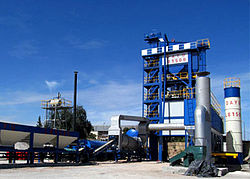Asphalt concrete
Asphalt concrete is a composite material.[1] It is commonly used to build roads, parking lots, airports, and embankment dams.[2] Asphalt mixtures have been used in making pavements since the beginning of the twentieth century.[3] It is made up of mineral aggregate bound together with asphalt. The process was made by Edward De Smedt.[4]
Asphalt mixtures
Mixing of asphalt and aggregate is done in one of several ways:
Hot-mix asphalt concrete (commonly abbreviated as HMA)
This is made by heating the asphalt binder to make it less viscous, and drying the aggregate to remove moisture from it before mixing it. Mixing is done at about 300 °F (roughly 150 °C) for virgin asphalt and 330 °F (166 °C) for polymer modified asphalt, and the asphalt cement at 200 °F (95 °C). HMA is used on roads with lots of traffic.
Warm-mix asphalt concrete (commonly abbreviated as WMA)
This is made by adding either zeolites, waxes, asphalt emulsions, or sometimes even water to the asphalt binder before mixing. It is good for the environment because small amounts of fossil fuels are used to make them. It also releases less carbon dioxide into the air. In 2012, a survey of producers that made asphalt in the US found that nearly 25% of asphalt made was warm mix.[5]
Cold-mix asphalt concrete
This is made by emulsifying the asphalt in water. It is done with an emulsifying agent before mixing. While it is emulsified, the asphalt is less viscous. The emulsion will break after enough water evaporates from it. Cold mix is commonly used on roads with less traffic.
Asphalt Concrete Media
As shown in this cross-section, many older roadways are smoothed by applying a thin layer of asphalt concrete to the existing Portland cement concrete, creating a composite pavement.
Asphaltic concrete laying machine in operation in Laredo, Texas
An airport taxiway, one of the uses of asphalt concrete
Asphalt damaged by frost heaves
References
- ↑ The American Heritage dictionary of the English language (5th ed.). Boston: Houghton Mifflin Harcourt. 2011. ISBN 978-0-547-04101-8. OCLC 701330646.
- ↑ "International Water Power and Dam Construction". 2012-07-07. Archived from the original on 2012-07-07. Retrieved 2021-05-09.
- ↑ Polaczyk, Pawel; Huang, Baoshan; Shu, Xiang; Gong, Hongren (2019-09-01). "Investigation into Locking Point of Asphalt Mixtures Utilizing Superpave and Marshall Compactors". Journal of Materials in Civil Engineering. 31 (9): 04019188. doi:10.1061/(ASCE)MT.1943-5533.0002839. ISSN 1943-5533. S2CID 197635732.
- ↑ Reid, Carlton (2015). Roads were not built for cars : How cyclists were the first to push for good roads & became the pioneers of motoring. Washington, DC. ISBN 978-1-61091-688-2. OCLC 906025798.
- ↑ "Survey finds growth in recycled materials for asph - CDR - Construction & Demolition Recycling". 2014-02-23. Archived from the original on 2014-02-23. Retrieved 2021-05-09.









